By artist and contributing writer Jacob Rivkin
What are the subtle histories embedded into each landscape? Floating Archives asks Philadelphians to consider our beloved “hidden river” as a source of narratives that tell of the ever-changing borders between land and water. (The original name for the Schuylkill River comes from the Lenni Lenape, Tool-Pay Hanna, which translates to Turtle River. The moniker ‘hidden river’ originates from the name given by Dutch settlers in Pennsylvania.) Some stories show us who shaped the river, and the funds and materials they used to harden its edges. Other stories are more difficult to surface, obscured by centuries of persistent structures of power and displaced ecologies of humans, animals, and plants. Floating Archives playfully and vividly reminds us of these submerged histories.
Floating Archives was a public art intervention on the lower Schuylkill River in Philadelphia. The project was supported through the Mellon Artist-in-Residence program at the Penn Program in the Environmental Humanities, in collaboration with Bartram’s Garden and the Science History Institute. On three Saturday evenings in September 2018, hand-drawn animations based on archival materials were projected on a screen suspended between two canoes. As these floating silent images present traces of the past in vibrant color, they invited us to see still other rivers, as they were, as they are, and as they could be. Specific animations were projected as Floating Archives approached the place that each original image referenced, creating a spectral layering of landscape, history, and wonder, both literally and figuratively. These drawings and animations also provoke us, in times of rising waters and changing coastlines, to consider the labor, capital, and energy that have and will shape the river’s future course.

Floating Archives on the Schuylkill River, 2018
The inspiration for Floating Archives originally came from making animations for a film on the history of taxidermy, and its contemporary alternative scene, with the Distillations podcast at the Science History Institute. The film, Death and Taxidermy, included animated explanations of the history, process, and personal stories involving taxidermy. The section on history included conducting research on advances in scientific methods of preservation and the buildings and landscapes where these scientific developments occurred. The process of reimagining physical actions and motions of people and animals in these historical spaces proved to be very enjoyable as an artistic practice. I started thinking about how I could bring this sensibility to my own independent research as an artist.
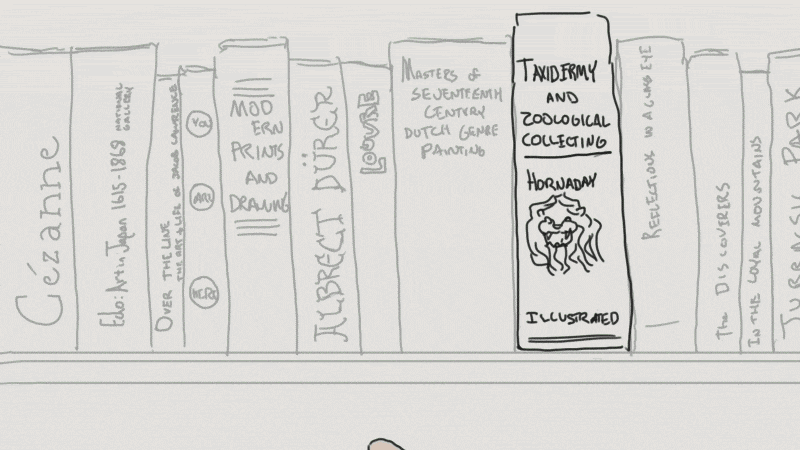
Clip from Death and Taxidermy, 2016
My work as an artist addresses how we experience and internalize the idea of landscape, and by association, wonder. These include creating devices that record the multi-sensory elements of a landscape through creative coding and physical computing, speculative biological systems, and films which explore the awakening of sentience and complexity within digital images. As an active canoer on the Schuylkill River in Philadelphia, I started thinking about the viewscapes created by the flow of water and the edges that border the river. Taking this as my lead, I started combing through digital archives and was led to reading Redemption of the Lower Schuylkill by John Frederick Lewis from 1924. This book, or perhaps manifesto, which contains a passionate argument for how the river in that time could be improved in cleanliness and recreation, is also filled with photographs and historical images of the river. This is where I would start the process of creating the animations for Floating Archives.
[vimeo 262669800 w=640 h=360]
The process for creating animations is as follows. I find an image that contains some portion of the Schuylkill River – this can be a photograph, etching, or drawing. All of the images came from archives or images that were digitized. This was necessary because I made most of the drawings and animations while participating in an arts residency at the Fine Arts Work Center during the winter of 2018 in Provincetown, MA. I then study the image for clues of what kind of industry, recreation, labor, or leisure may have taken place there, if it is not immediately apparent. This image is imported into a computer program specifically for hand-drawn animation. The image is cropped to either focus on the action or create a more visually engaging composition. The layer the image is placed onto is then locked, and the opacity is reduced to about eighty percent. On a new layer above, I use a digital pen and tablet to trace over the contours of the image below using a bright pink color with a two-point wide mark. This is so I can more easily delineate between the old and new background and ensure parts of the image below are not missed. A new layer is then created that contains the character or objects that are moving. Separating these different elements out of the image allow for further applications of independent motion or effects. The last elements to animate, also on separate layers, are the atmospheric effects of water, clouds, and smoke. The line drawings of the background layer and animation layers each receive its own independent color layer as well by using a paint bucket to fill in the outlines of the layer above. The process of creating several layers of images, motion, and color allows for the quick rearrangement of timing and compositing because less erasing and drawing is involved than if every image were on the same layer. For example, erasing the outline of a figure begins to erase the color and lines of the background. In the end, a final seamless two-dimensional animation is created.
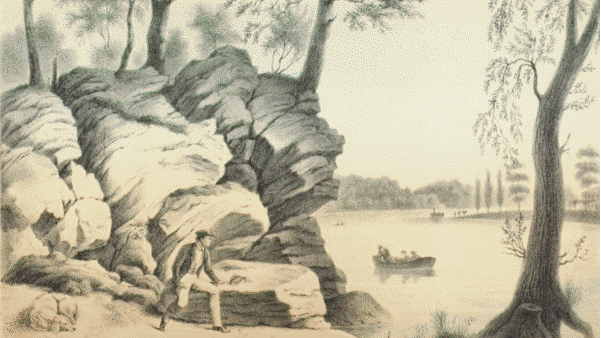
Animation is an accessible medium of communication. By translating archival images, many toned by the hue of time, into hand drawn animation containing consistent lines, weights, and vibrant colors, the original cultural currency imbued in the image is transformed into a source of contemplation, more playfulness, and less cultural gravity. The sense of seriousness contained within the original image can become a barrier for imagining the embedded narratives. The language of hand-drawn animation references a childlike association with Saturday morning cartoon series and films produced by Disney, and, by proxy, increases the sense of wonder around an image.
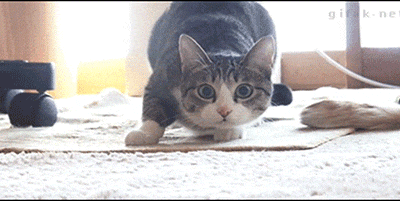
Shaq vs. Cat GIF
Moreover, the animations take their inspiration from the culture of GIF (Graphic Interchange Format) animations. GIFs are a file type originally associated with rotating logos and website “under construction” signs, which now exist as a quotidian form of communication and expression in digital culture. One important element of GIF animations is that embedded image and actions are on constant repeat, looping, sometimes seamlessly, in time. Each of the animations created for Floating Archives also loop seamlessly. The resonant link between history and repetition, the constant cycle of development and redevelopment, and the ebbing transition of wilderness to the flow of culture, seems analogous to the way images through history depicting the Schuylkill River have portrayed the river as a confluence of labor, resource extraction and transportation, and leisure.
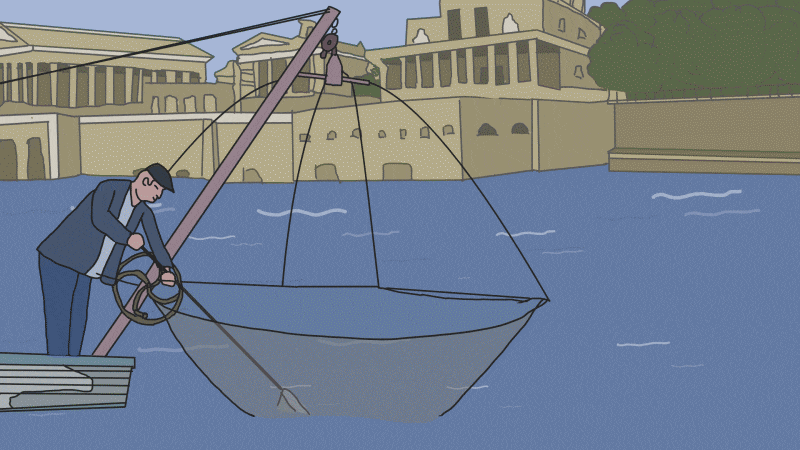
Man fishing with hand net on the Schuylkill River, 1927, Photo by Jacob Schuler,
Temple University George D. McDowell Philadelphia Evening Bulletin Collection
Water, progressing from higher elevations to lower ones, carries the sediment of upper creeks and tributaries to the shores and banks in the wetlands below. The movement is ever forwards. The physical history of a distant, yet interconnected, place becomes present for a brief geological moment, then continues its journey downstream and out to the vast ocean. In animation, one drawing follows another seamlessly. Images move forward sequentially in time to reveal the illusion of movement and convey meaning embedded into each frame. Yet, we cannot hold onto a particular image, as its meaning is conveyed by the images that came before and the images that come afterwards. By placing water and animation, these two vehicles of motion and meaning, in proximity to each other, Floating Archives can offer, for perhaps longer than a moment, a fleeting perspective of history and landscape illuminated by projection, streetlamps, and glimmering reflections in the river below.
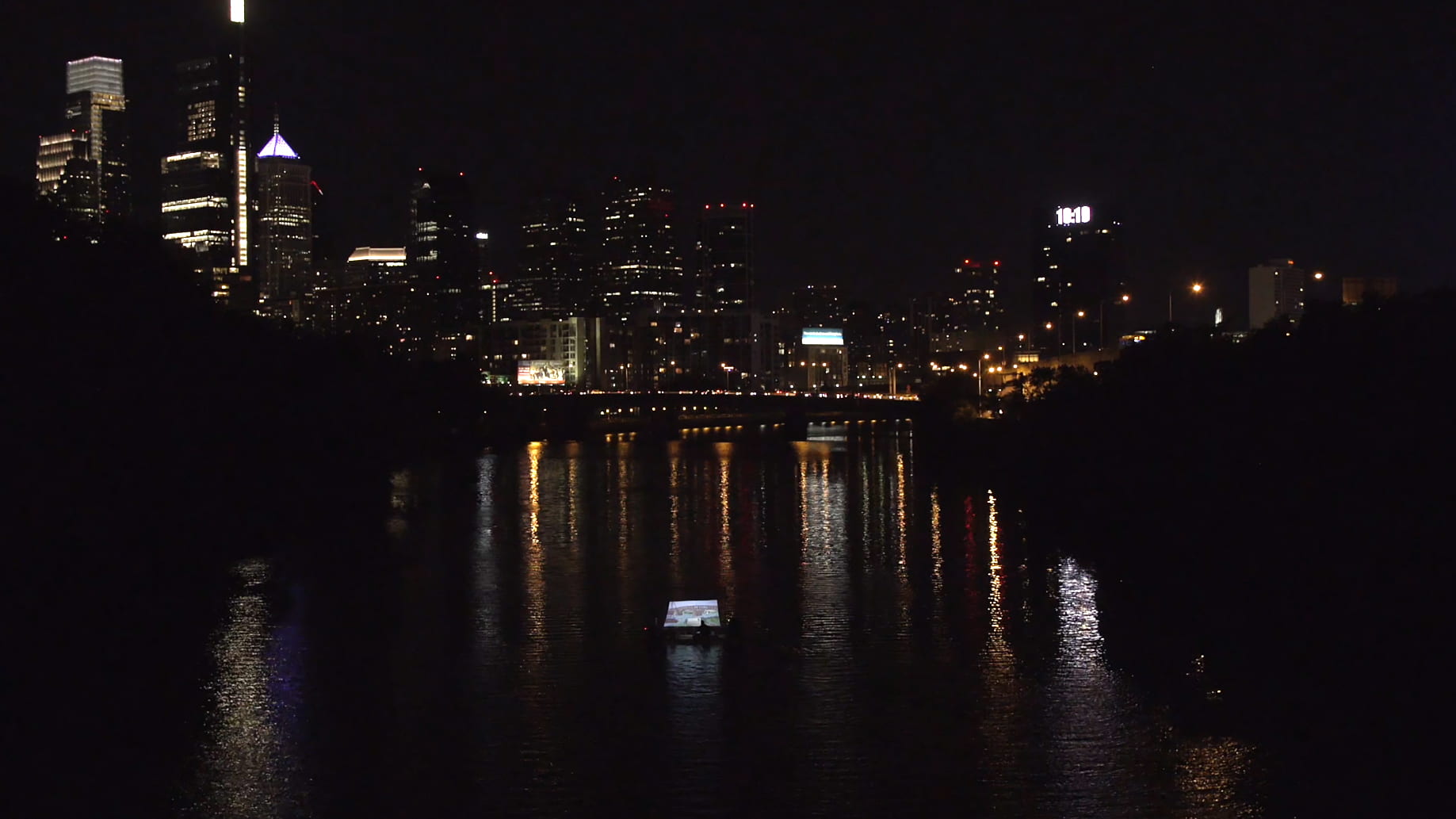
Floating Archives, 2018
Jacob Rivkin is an interdisciplinary artist living and working in Philadelphia, PA. He is a former Fulbright Fellow, a recipient of the Visual Arts Fellowship at the Fine Arts Work Center in Provincetown, and teaches Fine Arts courses at the University of Pennsylvania. His animations have screened at the Japan Media Arts Festival in Tokyo, Japan, Animation Block Party in Brooklyn, NY, Vox Populi in Philadelphia, PA, and the Peephole Cinema in San Francisco. His sculptures have been exhibited at the Vancouver Art Gallery in Vancouver, BC, The Chemical Heritage Foundation Museum, Philadelphia, PA, the Arlington Art Center in Arlington, VA and Julius Caesar Gallery in Chicago, IL. He previously worked with the Penn Program in the Environmental Humanities as an Ecotopian Toolmaker in 2017 with ecological designer Eric Blasco. Their project, the Bio Pool, was described by the Philadelphia Inquirer as “a giant Brita filter for the Schuylkill River.” It continues to filter water and be a habitat for cattails and red-winged blackbirds near the public dock at Bartram’s Garden.




Leave a Reply